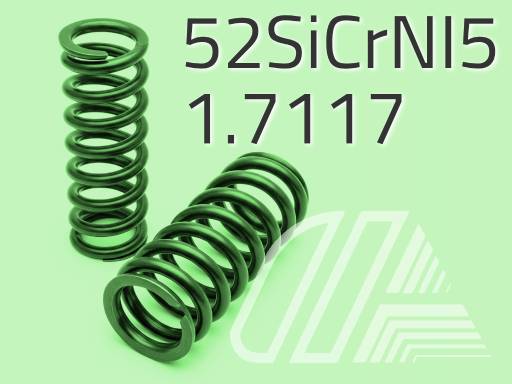The main properties of a spring steel are those of bearing an intermittent load, accumulating energy and measuring forces.
It must have an elastic deformation without plastic alteration, so the yielding unit load shall be elevated and this is achieved after an adequate quenching and tempering.
Spring steels must have an elevated hardenability, verified with the Jominy hardenability that allows to calculate martensite at heart that you can obtain, which has to be at least 80%.
In order to get a better elasticity and a high elastic limit, spring steels must have a fine grain to be less sensible to overheating.
They must have an elevated tensile strength and fatigue strength, combined with plastic reserve, consequently toughness is diminished.
Inclusions and superficial defects have to remain within restricted limits. Steels with SI, CR and NI have an elevated elastic limit and a great hardenability. They are employed for springs and twist bars.
Spring steels (EN 10089)
The main properties of a spring steel are those of bearing an intermittent load, accumulating energy and measuring forces.
It must have an elastic deformation without plastic alteration, so the yielding unit load shall be elevated and this is achieved after an adequate quenching and tempering.
Spring steels must have an elevated hardenability, verified with the Jominy hardenability that allows to calculate martensite at heart that you can obtain, which has to be at least 80%.
In order to get a better elasticity and a high elastic limit, spring steels must have a fine grain to be less sensible to overheating.
They must have an elevated tensile strength and fatigue strength, combined with plastic reserve, consequently toughness is diminished.
Inclusions and superficial defects have to remain within restricted limits. Steels with SI, CR and NI have an elevated elastic limit and a great hardenability. They are employed for springs and twist bars.
52SiCrNi5 (1.7117)
EN 10089
Annealed (+A) / Spheroidal Annealed (+AC)
PROPRERTIES AND APPLICATIONS
This type of steel has a very low density and melting point and is used in small and medium-sized statically loaded springs. A distinctive advantage of this grade is its ability to deliver improved performance compared to common alternatives such as 51CrV4 (1.8159) steel.
This steel is specifically employed in the production of small and medium-sized springs subjected to static loads. Its formulation makes it particularly suitable for hot-formed springs intended to withstand high stresses in vehicle engineering.

A high yield strength allows the material to withstand considerable loads before undergoing permanent deformation, maintaining its shape and functionality under operational stress.
Typical applications include:
- Turbine fasteners: Components that require high fatigue resistance and stability under dynamic loads and elevated temperatures.
- Connecting rods: Critical engine parts that endure significant cyclic compressive and tensile forces.
- Bolts and nuts: Used in assemblies that require high mechanical strength and the ability to maintain clamping force under stress.
- Gear shafts: Components subject to torsion and bending, where wear resistance and toughness are essential.
Additionally, 52SiCrNi5 (1.7117) steel is widely used in the automotive and railway industries for the production of coil springs and torsion/stabilizer bars. These steel grades must possess high yield strength and toughness after quenching and tempering in order to withstand stress under flexural-torsional loads.
CORRESPONDENCE TO INTERNATIONAL DESIGNATIONS
| QUALITY | EUROPE | GERMANY | FRANCE | SPAIN | G.B. | USA | |
|---|---|---|---|---|---|---|---|
| EN | DIN | W.n. | AFNOR | UNE | B.S. | AISI/SAE | |
| 52SiCrNi5 | 52SiCrNi5 | 52SiCrNi5 | 1.7117 | ~5160 | |||
CHEMICAL COMPOSITION % (UNI 3545)
| STEEL DESIGNATION | CHEMICAL COMPOSITION | |||||||||
|---|---|---|---|---|---|---|---|---|---|---|
| SYMBOLIC | NUMERIC | C | Si | Mn | P max | S max | Cr | Mo | Ni | V |
| 52SiCrNi5 | 1.7117 | 0,49 ÷ 0,56 | 1,20 ÷ 1,50 | 0,70 ÷ 0,90 | 0,035 | 0,035 | 0,70 ÷ 1,00 | - | 0,50 ÷ 0,70 | - |
MECHANICAL CHARACTERISTICS (UNI 3545)
| STEEL | 10mm | |||
| SYMBOLIC | NUMERIC | Re min | Rm | A min |
| N/mm2 | % | |||
| 52SiCrNi5 | 1.7117 | 1220 | 1400 to 1650 | 5 |
JOMINY HARDENABILITY (EN 10089:2022)
|
steel |
range limits |
HRC HARDNESS MEASURED FROM THE QUENCHED END OF THE TEST TUBE (MM) |
|||||||||||||||
|
designation |
Werk.no. |
1,5 |
3 |
5 |
7 |
9 |
11 |
13 |
15 |
20 |
25 |
30 |
35 |
40 |
45 |
50 |
|
|
52SiCrNi5 +H |
1.7117 +H |
max |
63 |
63 |
63 |
62 |
62 |
62 |
61 |
61 |
60 |
59 |
57 |
56 |
54 |
52 |
49 |
|
min |
58 |
58 |
58 |
57 |
57 |
56 |
55 |
54 |
51 |
48 |
44 |
42 |
40 |
38 |
36 |
||
|
52SiCrNi5 +HH |
1.7117 +HH |
max |
63 |
63 |
63 |
62 |
62 |
62 |
61 |
61 |
60 |
59 |
57 |
56 |
54 |
52 |
49 |
|
min |
56 |
56 |
55 |
55 |
54 |
53 |
52 |
51 |
47 |
42 |
38 |
35 |
33 |
31 |
30 |
||
USUALLY AVAILABLE ON STOCK
| M.T. COLORATION | QUALITY | HEAT TREATMENT | SURFACE | DIAMETER (mm) |
|---|---|---|---|---|
 |
52SiCrNi5 | Spheroidal annealed (+AC) | hot rolled | 20-200 |






